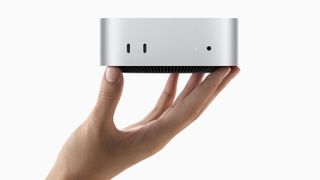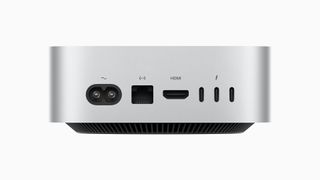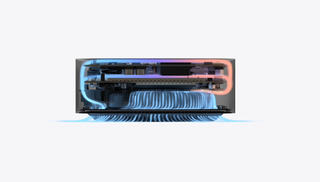Apple's redesigned M4, M4 Pro-powered Mac Mini is just 5 x 5 inches, packs up to 14 cores, puts the power button on the bottom
$599 to start, but 14-Core M4 Pro model starts at $1,599.

Apple has updated its smallest Mac in a big way today, by shrinking the desktop down to 5 x 5 inches while stepping up to its latest M4 and even M4 Pro silicon, which should make it quite the powerhouse for content creators with desk space constraints.
The company has also taken one step forward and one step back in usability over style, by adding ports to the front (two USB-C and an audio jack) as well as the back of the device (three Thunderbolt 4, HDMI, Gigabit Ethernet, and the power cable plug). The M4 Pro model steps up connectivity to Thunderbolt 5 – a first for Apple. But, in a move oddly reminiscent of the charging port placement of its Magic Mouse, Apple has moved the Mac Mini's power button to the bottom of the PC. Given how good sleep states are these days, it's unclear how much this will matter in terms of usability, but it's still an odd choice.

For those interested in AI, the new Mini of course includes the M4's Neural Engine and, on the M4 Pro, model up to 64GB of unified memory, with Apple claiming up to 273GB/s of memory bandwidth, which the company touts as "twice as much bandwidth as any AI PC chip" – an obvious jab at Microsoft's Copilot+ PC initiative.
Pricing starts reasonably enough, with the 10-core (and 10 GPU core) M4 Mac Mini starting at $599, with 16GB of RAM and a 256GB SSD. Like the iMac announced yesterday, the new Mac Mini has moved up from a base of 8GB of RAM. This is great for general use, but is also likely there to provide room for the new Apple Intelligence features that came as yesterday's macOS Sequoia 15.1 update. Going up in storage or memory will cost you the Apple-typical $200 per step. And you can go from Gigabit to 10-Gigabit Ethernet for an extra $100. $999 will get you 24GB of RAM and a 512GB SSD.
And the powerhouse M4 Pro model, with 12 CPU cores and 16 GPU cores, plus 24GB of RAM and a 512GB SSD starts at $1,399. From there, opting for the top-end 14-core M4 Pro costs an extra $200, and maxing out the storage (8TB at $2,400 extra) and RAM (64GB at $600 extra) takes you to an eye-watering $4,399 – or $4,499 if you also opt for 10GB Ethernet. That gets you firmly into Mac Studio territory, though that pro machine hasn't been updated since it was released with M2 Max and M2 Ultra.

Images of the cooling show that air comes in through the bottom, similar to the Mac Studio. There appear to be two boards for components, with some sort of connection. It's a tight fit that allows for the surprisingly small
Apple also says that it's the Carbon Neutral Mac, following the lead of the Apple Watch Series 9 and 10. Recycled components include the aluminum chassis, recycled gold plating in the motherboards, and rare elements in magnets. Unlike the iMac, the Mac Mini doesn't come with peripherals, so you'll have to bring your own keyboard and mouse.
The Mac Mini is available for pre-order now and will be generally available on November 8.
Stay On the Cutting Edge: Get the Tom's Hardware Newsletter
Get Tom's Hardware's best news and in-depth reviews, straight to your inbox.
After a rough start with the Mattel Aquarius as a child, Matt built his first PC in the late 1990s and ventured into mild PC modding in the early 2000s. He’s spent the last 15 years covering emerging technology for Smithsonian, Popular Science, and Consumer Reports, while testing components and PCs for Computer Shopper, PCMag and Digital Trends.
-
Giroro I don't trust any product image that prominently features a hand holding the product.Reply
Who is in charge of Apple's advertising, Temu? -
Syntaximus Why in the blue hell would you put the power button on the bottom of a device? :heink:Reply -
artk2219 So they made their own NUC, nice. Honestly it offers about what everyone else does for 600 on a new tiny PC. Thats the first time in a very very long time that i think ive been able to honestly say that about an Apple product.Reply -
artk2219 Reply
Because its Apple, its the same people that put the charge port for their wireless mouse on the bottom so you cant use it while its charging.Syntaximus said:Why in the blue hell would you put the power button on the bottom of a device? :heink: -
Neilbob There's a hand there because Apple didn't want to be overtly pushy in marketing the forthcoming super-special stand that only costs 1,299.Reply -
Notton They could have done this starting with the M1. There was a ton of void space in all of the M series mini-macs.Reply
power button on the bottom is a big wth... -
RUSerious Reply
They've had their own 'NUC' for a while. (~5 years b/4 Intel).artk2219 said:So they made their own NUC, nice
Most Popular




